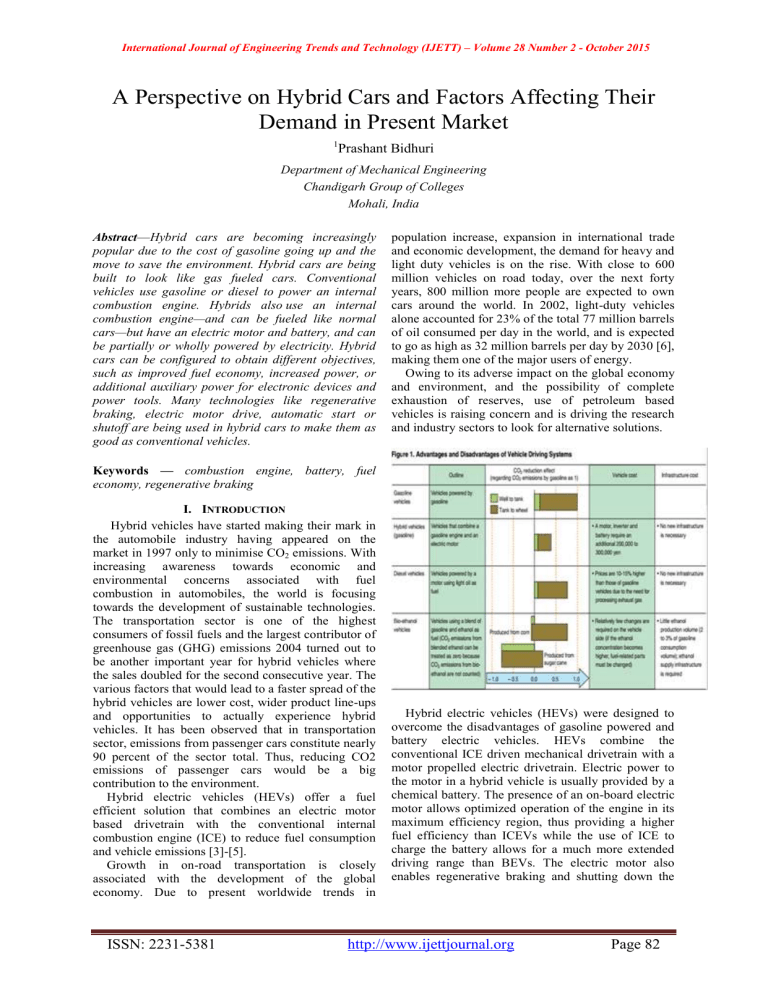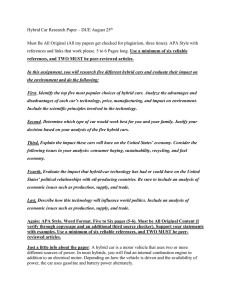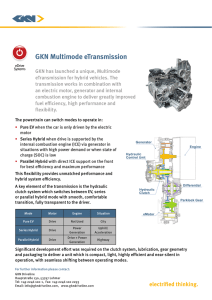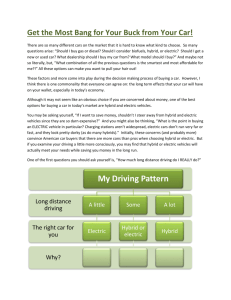Document 12915570
advertisement

International Journal of Engineering Trends and Technology (IJETT) – Volume 28 Number 2 - October 2015 A Perspective on Hybrid Cars and Factors Affecting Their Demand in Present Market 1 Prashant Bidhuri Department of Mechanical Engineering Chandigarh Group of Colleges Mohali, India Abstract—Hybrid cars are becoming increasingly popular due to the cost of gasoline going up and the move to save the environment. Hybrid cars are being built to look like gas fueled cars. Conventional vehicles use gasoline or diesel to power an internal combustion engine. Hybrids also use an internal combustion engine—and can be fueled like normal cars—but have an electric motor and battery, and can be partially or wholly powered by electricity. Hybrid cars can be configured to obtain different objectives, such as improved fuel economy, increased power, or additional auxiliary power for electronic devices and power tools. Many technologies like regenerative braking, electric motor drive, automatic start or shutoff are being used in hybrid cars to make them as good as conventional vehicles. population increase, expansion in international trade and economic development, the demand for heavy and light duty vehicles is on the rise. With close to 600 million vehicles on road today, over the next forty years, 800 million more people are expected to own cars around the world. In 2002, light-duty vehicles alone accounted for 23% of the total 77 million barrels of oil consumed per day in the world, and is expected to go as high as 32 million barrels per day by 2030 [6], making them one of the major users of energy. Owing to its adverse impact on the global economy and environment, and the possibility of complete exhaustion of reserves, use of petroleum based vehicles is raising concern and is driving the research and industry sectors to look for alternative solutions. Keywords — combustion engine, battery, fuel economy, regenerative braking I. INTRODUCTION Hybrid vehicles have started making their mark in the automobile industry having appeared on the market in 1997 only to minimise CO2 emissions. With increasing awareness towards economic and environmental concerns associated with fuel combustion in automobiles, the world is focusing towards the development of sustainable technologies. The transportation sector is one of the highest consumers of fossil fuels and the largest contributor of greenhouse gas (GHG) emissions 2004 turned out to be another important year for hybrid vehicles where the sales doubled for the second consecutive year. The various factors that would lead to a faster spread of the hybrid vehicles are lower cost, wider product line-ups and opportunities to actually experience hybrid vehicles. It has been observed that in transportation sector, emissions from passenger cars constitute nearly 90 percent of the sector total. Thus, reducing CO2 emissions of passenger cars would be a big contribution to the environment. Hybrid electric vehicles (HEVs) offer a fuel efficient solution that combines an electric motor based drivetrain with the conventional internal combustion engine (ICE) to reduce fuel consumption and vehicle emissions [3]-[5]. Growth in on-road transportation is closely associated with the development of the global economy. Due to present worldwide trends in ISSN: 2231-5381 Hybrid electric vehicles (HEVs) were designed to overcome the disadvantages of gasoline powered and battery electric vehicles. HEVs combine the conventional ICE driven mechanical drivetrain with a motor propelled electric drivetrain. Electric power to the motor in a hybrid vehicle is usually provided by a chemical battery. The presence of an on-board electric motor allows optimized operation of the engine in its maximum efficiency region, thus providing a higher fuel efficiency than ICEVs while the use of ICE to charge the battery allows for a much more extended driving range than BEVs. The electric motor also enables regenerative braking and shutting down the http://www.ijettjournal.org Page 82 International Journal of Engineering Trends and Technology (IJETT) – Volume 28 Number 2 - October 2015 engine during idling further increases the efficiency of the vehicle. Fig. 3 Basic Hybrid Car Parts II. FACTORS AFFECTING DEMAND There are still some downsides with hybrid cars. The small amount of pollution they produced, the pollution from the factories making these cars, and the Fig. 2 (a) Battery electric (b) fuel Cell (c) Hybrid Electric chemicals used in powering the fuel cell cars. Hybrid cars will make a difference because of its Obviously if a hybrid car has a gas engine than there almost zero emissions and the money it saves on gas. will be some pollution produced but still a substantial Just think of being able to drive twice as far on a tank amount less than normal gas cars. Where a car or of gas and saving money while doing it. A hybrid car anything is produced by a factory, there will be is a car with both a gas powered engine and an electric pollution. With the development of these new cars motor. The electric motor is powered by batteries, there might be new technologies that will improve the which are recharged while driving the same way as way things are made. The fuel cell cars also have a with a normal car battery. The gas engine is the same disadvantage and that is the chemicals needed to run as one that would be found in a normal car. These two the car. Even though there are some negatives with the power sources can be used simultaneously or by alternative cars the more they will be used the more themselves depending on what the car is doing. An improvements will be made to make them even better electric car is one that runs purely off an electric than they already are. There are many factors that are responsible for slow motor that is run off batteries. When not in use the car is plugged in by a special plug to recharge the sale of hybrid cars, such as: Lack of Information to Consumer: There are many batteries. A fuel cell car runs off a special engine that runs off hydrogen, oxygen, and other chemicals. The misconceptions associated with the fairly new hybrid advantage of this is the only by-product is water technology that mislead consumers. One such instead of carbon monoxide, carbon dioxide like misconception is the high maintenance cost on regular car engines, and other pollutants. The world is batteries. Battery replacement can cost two to three in need of an alternative car to stop the pollution and thousand dollars, however most manufacturers now the large amounts of carbon dioxide in our atmosphere. offer 8-10 years/240,000 km warrantees and in The good thing with hybrid cars is the emissions and coming years, with the progress in battery technology, gas mileage. With low emissions comes significantly this warrantee is expected to go up to vehicle life. less pollution. Hybrid cars have good gas mileage Financial Limitations: The high initial cost of since they do not run entirely off the engine. With good gas mileage comes a reduced need for gas so it hybrids is the main cause of low sales. Most hybrids will be conserved and there would be a lesser chance cost seven to twelve thousand dollars more than their of a shortage. Needing less gas would also lower gas non-hybrid versions of vehicles of the same class. This prices. The hybrid cars are also equipped with good increase in cost is attributed to low demand and higher aerodynamics to reduce drag, which helps the car to cost of additional electric components, particularly the run smoother and not need as much fuel. By using battery. both a conventional engine and electric motor, the best Challenges in Technology: The addition of hybrids achieve significantly better fuel efficiency than their non-hybrid counterparts. They also pollute electrical components to the vehicle traction system makes the design and control of hybrid electric less and save drivers money through fuel savings. vehicles a challenging task. Drivetrain components ISSN: 2231-5381 http://www.ijettjournal.org Page 83 International Journal of Engineering Trends and Technology (IJETT) – Volume 28 Number 2 - October 2015 have to be designed specifically to HEV application such that the vehicle performance can compete with all other available automobiles in the market. In this regard, hybrid vehicles have several challenges to overcome, particularly in the design and control of their electric drivetrain for enhanced driving performance, advancement in battery technology for longer life, lighter weight and higher power density, and the improvement in the spaciousness of the vehicles to satisfy consumer expectation. always putting pressure on its suppliers to cut costs. If the component manufacturers were able to refine their technologies so as to miniaturize components and consequently reduce their manufacturing cost, they will profit from their participation in hybrid car market. III. CONCLUSIONS The production of the hybrid car will continue, as popularity increases, and the people will enjoy in the tax saving and the features that the hybrid automobile There are some other downsides also that the brings to the benefit of the people. consumer will get with the purchase of a hybrid car. In conclusion, hybrid cars will be the next The main disadvantage with almost all electric, hybrid, alternative to fuel vehicle. Their demand is increasing, and fuel cell cars is the low amounts of power. not only in America, but worldwide. Asia countries, such as Japan, Korea and Singapore owners of hybrid cars are enjoying tax relief from switching to hybrid motor. It is inevitable that fuel motor cars model will be going down to history and hybrid cars is making a history. REFERENCES [1] [2] [3] [4] [5] [6] [7] [8] Statistics Canada Report: Energy Statistics Handbook – Fourth Quarter 2007, Catalogue no.57-601-X, April 2008. Transport Canada Report: Transportation in Canada – An Overview, Catalogue no. TP 14816E, 2007. I. Husain, Electric and Hybrid Vehicles-Design Fundamentals, Boca Raton, CRC Press, 2003. D. J. Santini, P. D. Patterson, and A. D. Vyas, Importance of vehicle costs, fuel prices, and fuel efficiency in hybrid electric vehicle market success, Transportation Research Record, Issue 1738, pp. 11 - 19, 2000. D. Hermance and S. Sasaki, Hybrid electric vehicles take to the streets, IEEE Spectrum, vol. 35, pp. 48-52, Nov. 1998. World Energy Outlook 2004, International Energy Agency (IEA). Satti Swami Reddy , Kola Siva Tharun, Eco Friendly Vehicle (Hybrid Electric Vehicle), IJETT, Volume 4 Issue 4- April 2013 Surender Dhanasekaran, A Review On Evolution Of Hybrid And Electric Vehicle, International Journal of Engineering Sciences & Research Technology, ISSN: 2277-9655. Fig. 4 Expectations of Users It is likely that we would be able to see some increase in the size of the hybrid car market. Though, there is no doubt that the market must have a wider line-up of models offered at prices that are more competitive. The main issue that the industry is facing is how to offer smaller-sized components that can be manufactured for lower cost. While many electrical equipment and component manufacturers have set up dedicated automotive marketing divisions and research centres. They do not have any means of identifying the needs of the major manufacturers. The growth of the hybrid car market will require that hybrid systems are made smaller and offered at lower cost. For the electrical components manufacturers the industry provides quite stable outlet. At the same time, the industry demands a high level of quality and is ISSN: 2231-5381 http://www.ijettjournal.org Page 84




